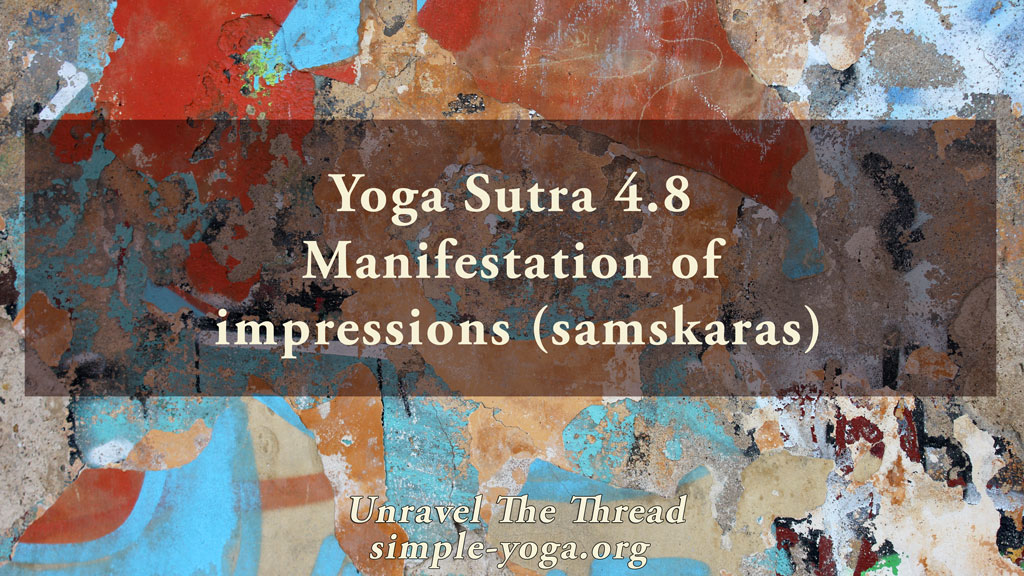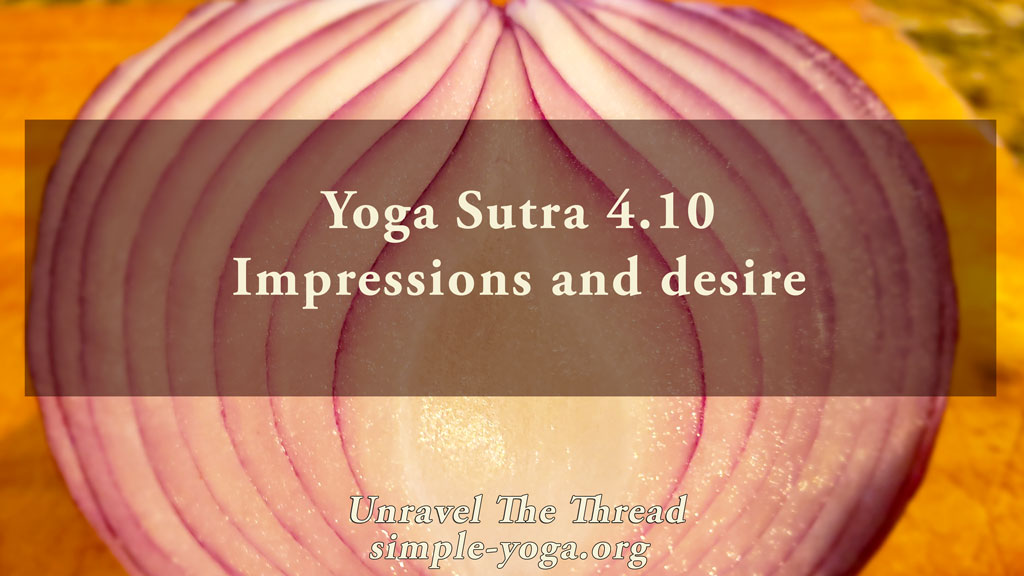4.9 Unique configuration of impressions (samskaras)

4.9 All actions result in accumulated impressions (samskaras) linked to memory in a unique configuration regardless of the time, place, or circumstances in which those impressions emerged.
Any activity you do has a beginning and an end. All activities leave impressions in your memory. The more meaningful the motivation for the activity and the stronger your emotional investment in it, the stronger its impression. These impressions include all kinds of emotions. Emotion is the glue that keeps all these impressions together and attached to yourself. As mentioned in the previous aphorism, these impressions are seeds that influence your actions and inclinations. When you tasted something sweet like ice cream or chocolate for the very first time, the experience left an impression in you. That impression is reinforced every time that you have a similar experience. The next time you eat that type of food, you will remember previous times, places, and circumstances when you had a similar experience, strengthening the hold of those impressions. Some of those impressions may be in your conscious awareness while others may be stored in your subconscious mind.
This sutra takes this idea further by saying that the impressions from all your actions, thoughts and intentions are linked to your memory in a unique way. This aggregate of impressions becomes part of your ways of being. As long as the impression generates some level of emotional reactivity, it will remain and, as it was pointed out in aphorism 4.8, the impressions remain dormant until a propitious time for them to emerge. Over time, these impressions accumulate subconsciously and create a feedback loop of associations that generates tendencies and recurring experiences. The resulting experiences offer potential lessons that have not been fully assimilated and thus will need to emerge again until they do not generate any emotional reactivity. When these impressions remain active, they perpetuate your process of living through your karma, as mentioned in sutras 4.7, 2.12, 2.13 and 2.14.
As you become familiar with your ways of being, can you notice if these ways of being tend to appear again and again?
Do your ways of being seem to overlap?
Are those ways of being related to your beliefs and opinions?
If your ways of being seem to repeat, is it possible that the external circumstances of their manifestation might differ, but their emotional content and agitation may be the same?
For instance, if you keep getting frustrated by a diverse set of circumstances and people, could it be that there is an unresolved previous emotional experience common to these irritations, like a deeply ingrained feeling of scarcity, or a deeply seated need for approval?
Might it be possible that this collection of impressions, when unresolved, remains in your individual space of awareness offering you ways to overcome your identification with these experiences?
If you trace the irritants that bother you, can they be trying to show you what needs to be released so that these experiences do not become another source of misidentification?
For instance, the person who finds it difficult to voice his needs will find himself in situation after situation prompting him to assert his voice until he can finally do it. Consider if the unique configuration of impressions and emerging circumstances for their resolution are perfectly calibrated for you to decrease or remove some of your ways of being.
One traditional interpretation of this sutra indicates that the conglomerate of impressions and memory continues from one lifetime to the next in a potentially endless cycle of life, death, and rebirth (samsara). This unique collection of memories and impressions is what some people call the individual soul. There is a controversial idea about recipients of organ donation experiencing new cravings and predilections matching those of the organ donor. Other recipients of organ donation have reported unusual dreams that seem to coincide with traumatic experiences lived by the organ donors close to the time of their demise. These stories are controversial because there are no ways to prove or disprove them. However, if these reports are true, would it be possible for the impressions of previous actions to be stored in our organs through some mechanism that we do not understand yet? Furthermore, decades of rigorous research on children who remember their previous lives suggests that consciousness survives death, remaining even when the bond to the physical body has been severed.
Can these stories about transfer of some personal traits from one person to another point to how awareness infuses our embodied existence?
Also, if some personal tendencies (vasanas) can survive after death, might this suggest that the journey of learning extends beyond this lifetime?
Is it possible then that your unique configuration of memories, impressions and tendencies continues from one life to the next?
As usual, one more way of exploring the meaning of this sutra is by chanting it.
You can choose to chant it in its traditional form with some of the words coming together:
4.9 jāti deśa kāla vyavahitānāmapyānantaryāṃ smṛtisaṃskārayoḥ ekarūpatvāt
जाति देश काल व्यवहितानामप्यानन्तर्यां स्मृतिसंस्कारयोः एकरूपत्वात् ॥९॥
Another option is to chant each word in the sutra individually:
- jāti
- deśa
- kāla
- vyavahitānām
- api
- ānantaryāṃ
- smṛti
- saṃskārayoḥ
- eka
- rūpatvāt
If you prefer, you may listen to the podcast:
This is an excerpt from the book Unravel the thread: Applying the ancient wisdom of yoga to live a happy life
If you find Simple-Yoga.org and Unravel the thread useful, consider supporting my labor with a donation, you may also donate using PayPal or Venmo. Thank you!


